A vegan gluten free sourdough bread recipe made with whole grain sprouted gluten free flours, gluten free sourdough starter based that doesn’t require kneading shaping or a Dutch oven. This easy gluten free vegan sourdough bread recipe has, no xanthan gum, no eggs, no dairy, no oil, no high starch flours, no sugar, no yeast, making it the best gluten free healthy bread recipe – just perfect for a clean eating diet.
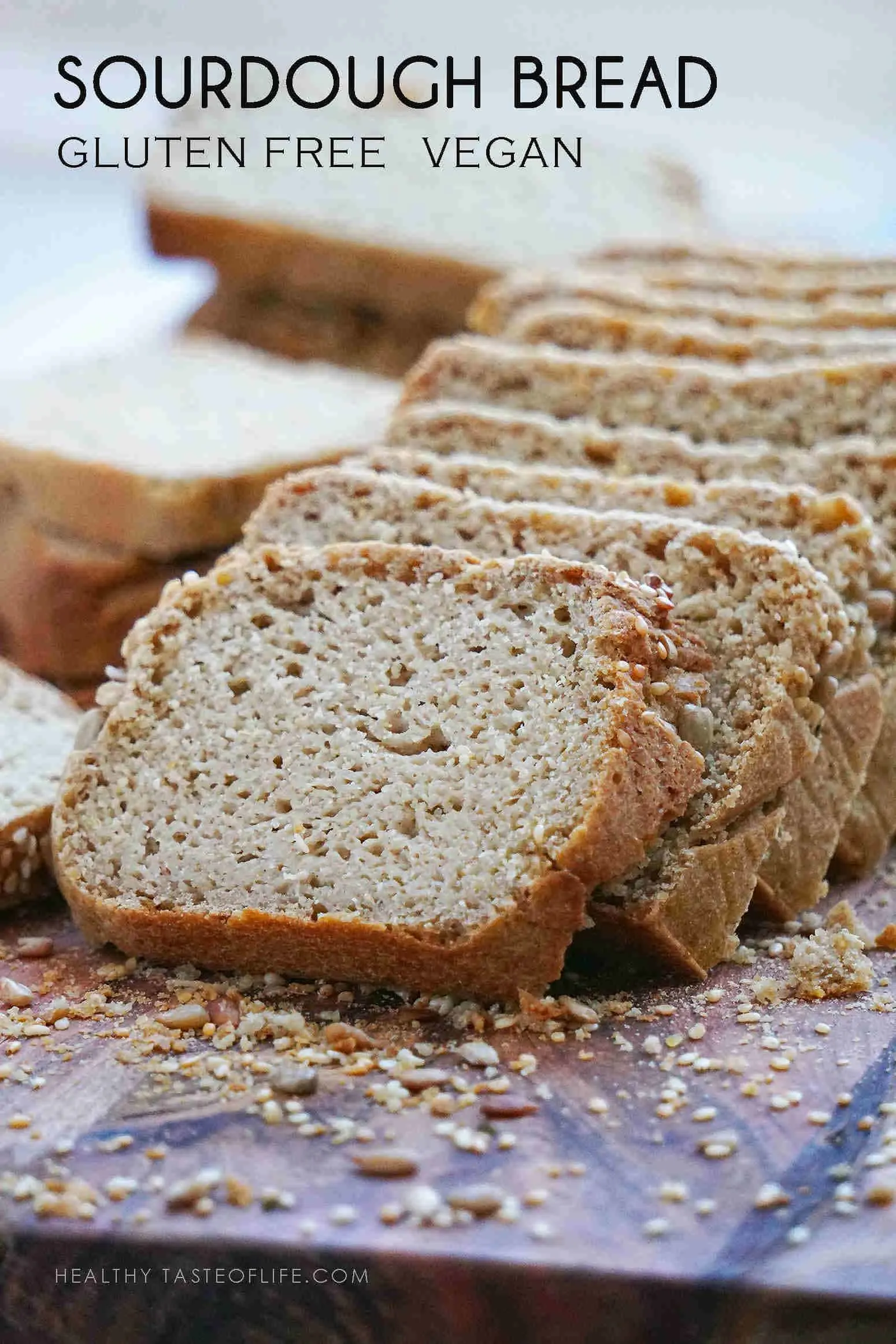
Healthy Gluten Free Sourdough Bread Recipe (Vegan)
Finding a healthy gluten free bread recipe it’s not that simple. Most of them have undesirable ingredients that celiac and sensitive people still react to. These usually have as ingredients xanthan gum, starch flours, eggs, cheap oils or commercial yeast.
The healthiest way to make a tasty loaf of vegan gluten free bread that cuts without crumbling and falling apart, is quite a challenge. But it’s possible! I’m making this gluten free sourdough bread recipe every week for the last 5 years!
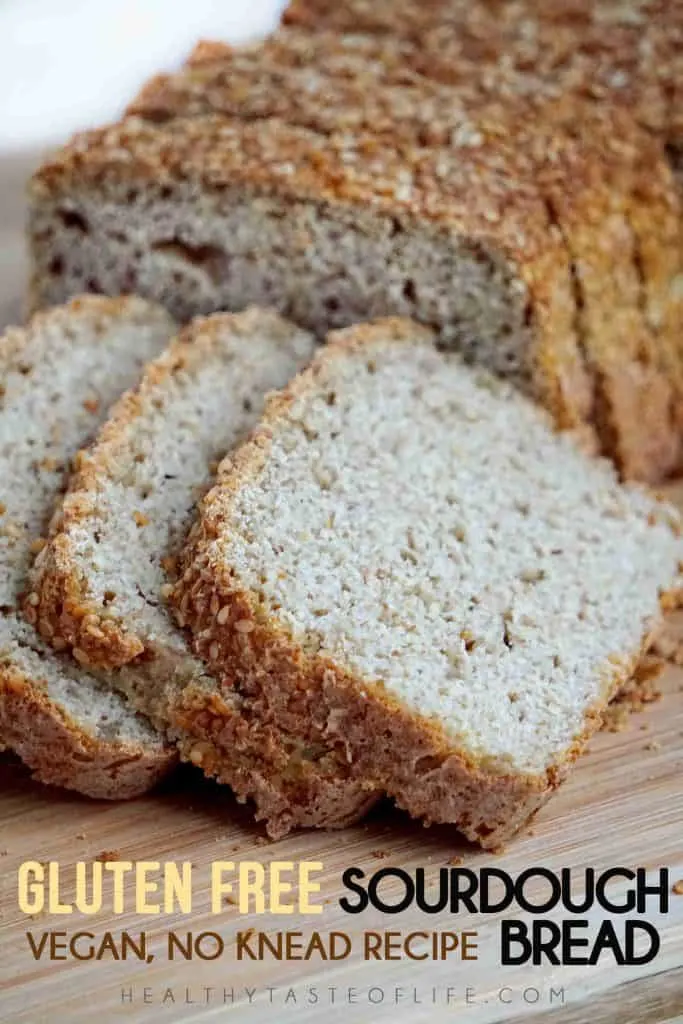
For A Perfect Vegan Gluten Free Bread You Need A Sourdough Starter
There is no right recipe for gluten free sourdough bread because everyone uses different methods and they all get good results. It’s all about a balanced ratio of flours, a good sourdough starter and patience. The sourdough starter helps the bread rise and provides flavor without using yeast and baking powder.
So to ensure a well risen loaf with a good structure, I had to get my hands on an active gluten free sourdough starter. I admit, at first I was a bit intimidated because I wasn’t sure what I would do with so much starter, but then I realized that it can be used for so many recipes.
I use it in these gluten free sourdough bread buns, my favorite vegan gluten free pumpernickel bread or this gluten free vegan sourdough banana bread, these gluten free sourdough crackers and these gluten free sourdough tortillas (wraps) which are all also gum free and egg free.
What Makes This Gluten Free Sourdough Bread Healthy
- My gluten free vegan sourdough bread uses only unprocessed whole food ingredients, no artificial additives, preservatives, or soy derivatives.
- The recipe uses gluten free sprouted flours like brown rice flour, buckwheat flour, oat (or millet) flour. This is especially great for people having a hard time digesting starches, typically when dealing with allergies and food sensitivities. Sprouting minimizes the presence of phytic acid (known as a mineral blocker or enzyme inhibitor), it breaks down the grains’ starches into simple sugars that are very easily digested afterwards.
- This gluten free bread recipe is xanthan gum free, yeast free, nut free and without psyllium husk because these created gastrointestinal discomfort for me.
- The slow fermentation process allows bacteria to fully break down the carbohydrates which basically pre-digests the bread making it easier to digest.
Since baking gluten free I managed to switch entirely to only using sourdough and I use it in most of my favorite breads, rolls, tortillas, muffins and naan, you can find these in my cookbook.
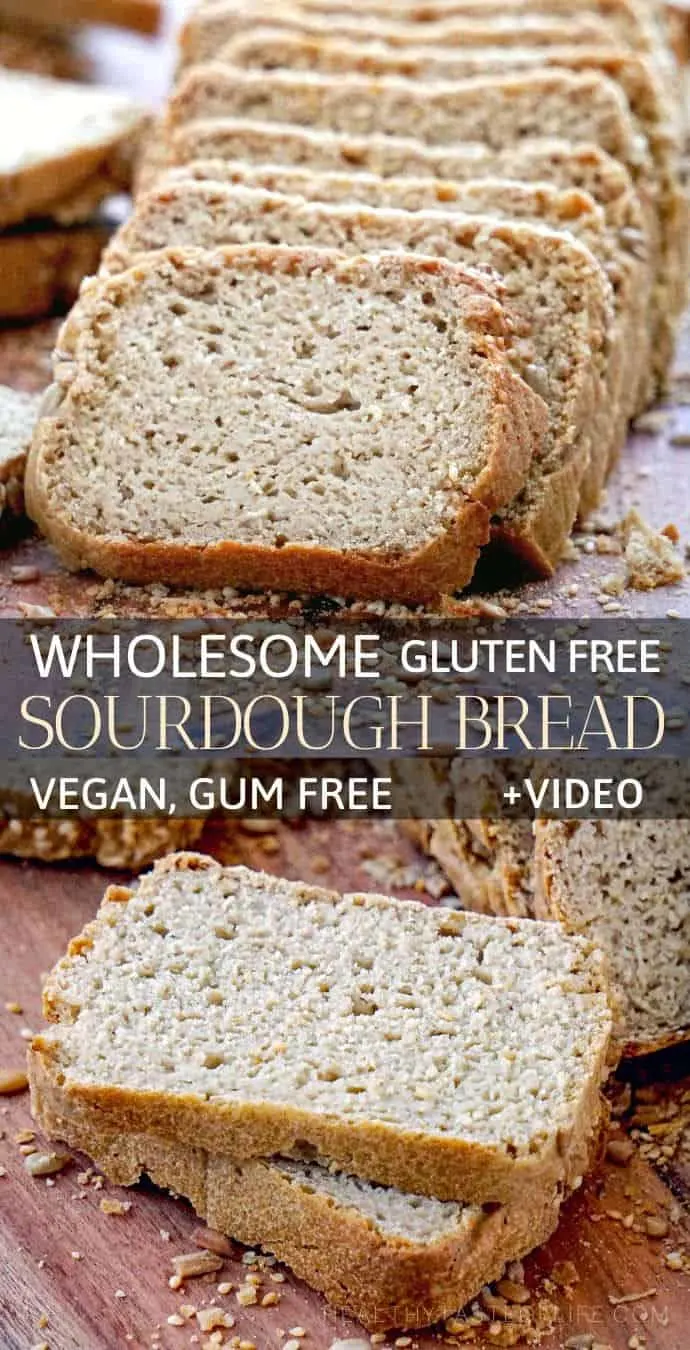
Reasons To Try A Vegan Gluten Free Sourdough Bread Recipe
- Easy to make and easy to store for longer periods of time (freezer) just throw some slices in your toaster whenever you want a sandwich.
- This sourdough starter is very easy to care for and maintain. I store it in the refrigerator, feeding it just once a week.
- Because of the acids and bacteria naturally present in the starter, the gluten free sourdough breads tend to have a longer shelf life than their commercial yeast-based counterparts.
Vegan Gluten Free Sourdough Bread Without Xanthan Gum
Most people use gums (guar, xanthan) to get a beautiful shape and texture for their vegan gluten free bread, but I had to keep my list of ingredients as close to real food as possible.
Some of the registered side effects of xanthan gum consumption is: intestinal gas, bloating, flu-like symptoms, nose and throat irritation, and lung problems. And I definitely felt some of them.
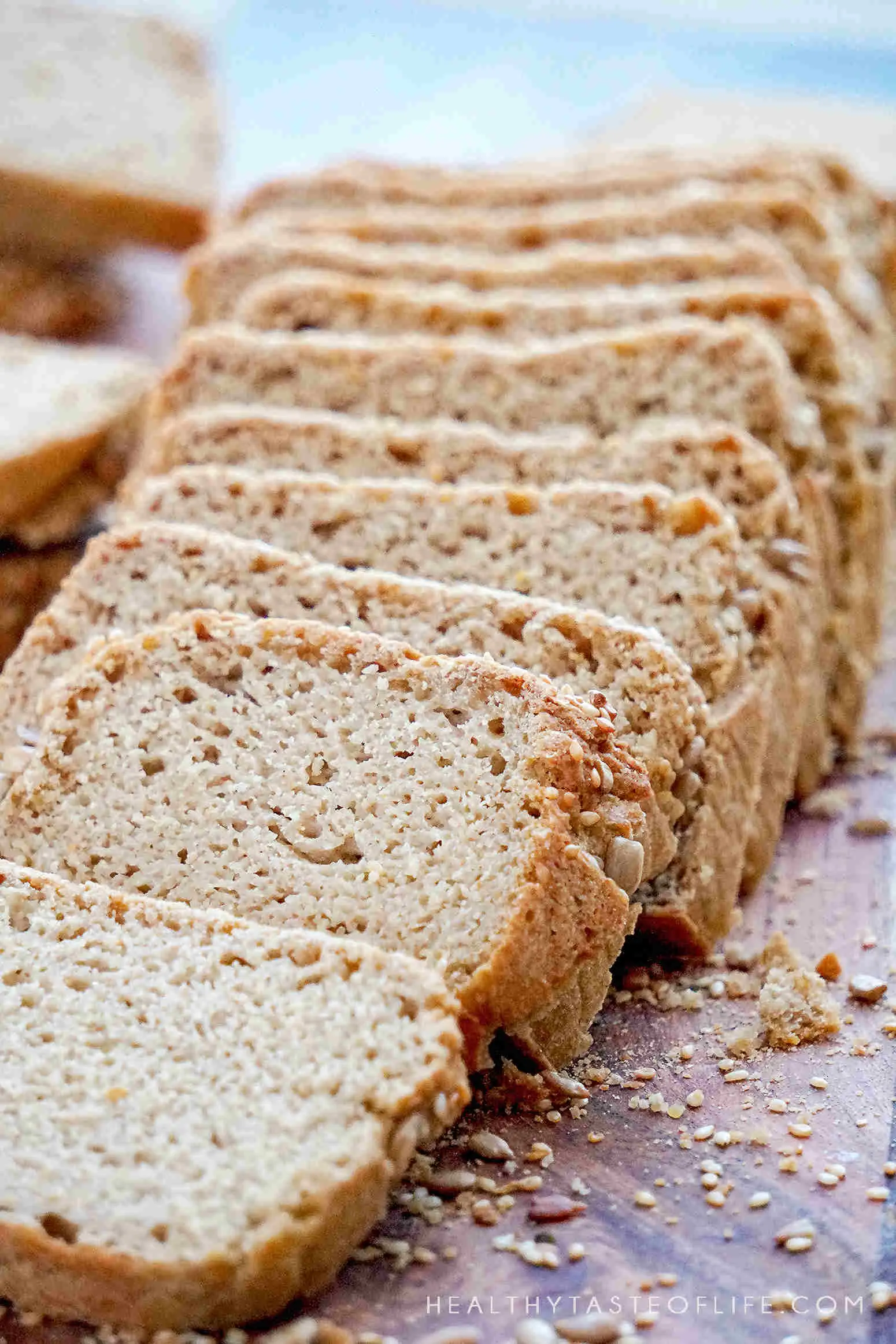
Vegan Gluten Free Sourdough Bread Without Dutch Oven
You don’t need to invest in a dutch oven to make this gluten free sourdough bread. And even if you have one I don’t recommend using it, because the dough is not stiff enough to hold it’s shape without walls of a loaf pan. The walls keep the rising upwards and not on the sides.
The best thing I found for easier gluten free sourdough bread baking is this adjustable oval baking frame or tin without a base. It has no bottom so it’s easy to remove while baking. And since it extends in and out easily it works well for any bread size if you decide to bake a larger loaf than anticipated.
Another great option is a high wall non-stick loaf tin, you don’t even need parchment paper for this.

How To Make Vegan Gluten Free Sourdough Bread
Instead of using yeast, I let the natural fermentation do it’s job. As a leavening agent I’m using a gluten free sourdough starter from Cultures For Health. Or you can aslo find it here on Amazon – which is maintained with brown rice flour. This is the easiest and convenient way if you don’t have milk/water kefir on hand.
So here are the steps for making a gluten free sourdough bread:
Step 1. Make or Prepare The Gluten Free Sourdough Starter
If you decided to make your own gluten free sourdough starter, you have 3 options:
- Make it from scratch with just whole grain gluten free flours and water (a less reliable method).
- Add a helper: fruits, cabbage leaves, or water kefir.
- Or buy a starter culture that also acts like an aid and ensures that the whole process of making a gluten free sourdough starter is successful.
For all 3 methods you need mostly filtered water, flour, and the same amount of time (about 6-9 days).

I’m using method number 3 – with a sourdough culture (which is basically an established starter, packed in a dehydrated form, made from brown rice) because it gives me the peace of mind that it won’t fail. I have a post showing how to start a gluten free sourdough starter, how to maintain, store and troubleshooting tips with pictures and video.
So once it’s ready, or if you already have an established starter that sits in the fridge, here are the next steps:
Step 2. Feed the starter until its bubbly and active:
- Take the amount of starter you need, the rest feed it and place it back in the fridge.
- To that add 1/2 cup of brown rice flour, and 1/2 cup of filtered water. This step will activate the cold dormant starter. If your starter is thin and watery, use less water (about 1/3 cup). Let it sit in a warm (not hot) place for 3-4 hours until is light and bubbly. During winter it might take even 5 hours.
- If the starter is not too active (you don’t see too many bubbles) feed it again (brown rice flour + water). But you will need to use only 1 cup of starter for the recipe, the rest you can place in the fridge or use for another recipe.
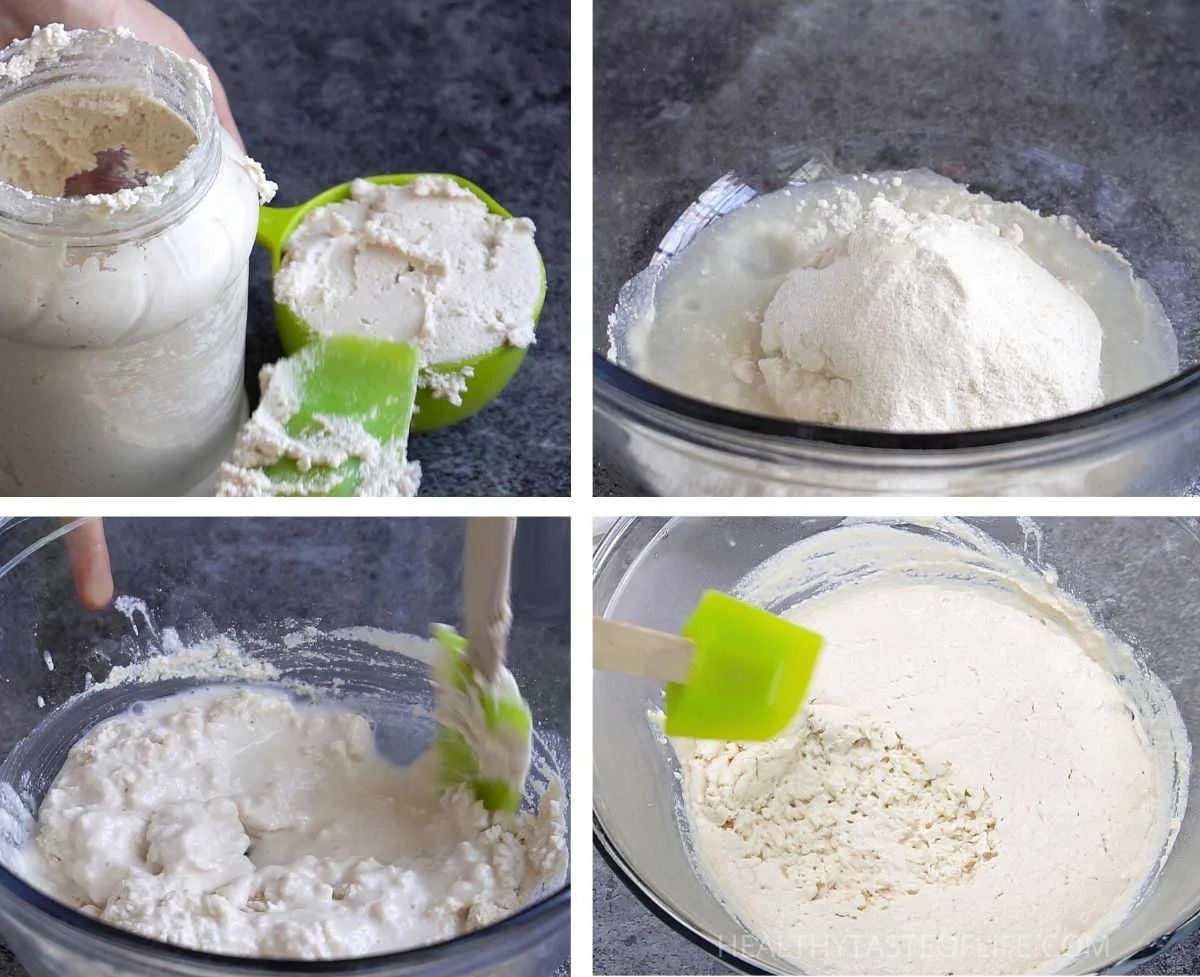
Step 3. Form The Gluten Free Sourdough Loaf:
- To the active starter add the rest of ingredients: the flours (sifted), water, salt and maple syrup (it’s optional, but I use to enhance the taste plus the sugar makes the bread rise faster). You can use the exact ingredients provided in this recipe but you can also customize it by trying a variety of flours with higher nutritional quality in terms of fibre, vitamins and minerals. Like buckwheat, amaranth, quinoa, oat, flax seed, sorghum etc. Make sure to read below about the best flour to use in gluten free sourdough bread baking.
- If you’re using 2nd recipe version, where I added more ground flax seeds and psyllium husk (this provides extra pliability) you’ll need a little bit more moisture so I increased the amount of water to 2 cups. First you combine the starter with water and psyllium husk, mix to combine, so it can expand a little bit. And then you add the rest of ingredients.
- Mix. The dough should look like a thick batter or like a brownie batter. No kneading is required.
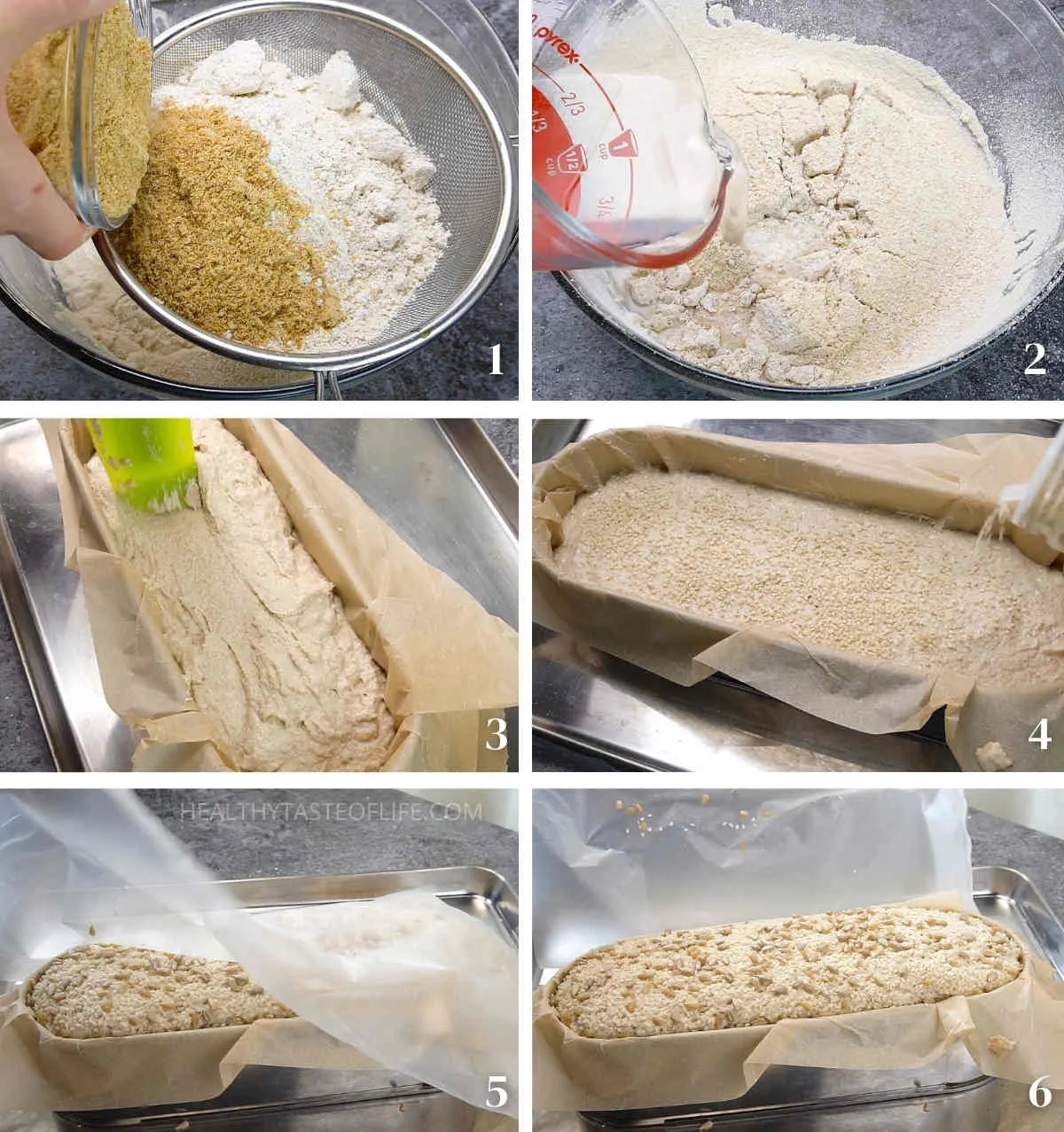
Step 4. Gluten Free Sourdough Bread Proofing:
- Scrape the dough into the pan and smooth it out with a spatula to produce a nice dome shape. Add seeds or nuts on top if you want.
- Cover with a plastic wrap or a towel to seal moisture (you can also spray the inside of the wrap with water to prevent dough cracking) and let it rise in a warm place approximately 4-5 hours. It depends on how warm is your kitchen.
Step 5. Bake The Bread:
- Preheat oven at 425 degrees F (220 C).
- Once ready to bake the bread, remove the wrap, cover with an aluminum foil (without touching it), turn the temperature down to 390 F (200 C) and bake for 30 minutes.
- Then remove the foil (at this time you can also remove the baking tin for an uniform baking on all sides) and bake for another 40-45 minutes until golden brown.
- Allow to cool completely before handling or slicing (use a serrated knife)! Best to do that the next day.

I also made a video tutorial to help you understand the process of making this gluten free sourdough bread recipe more easily.
Although it’s been a while since making this recipe, with experimenting, it has changed and improved. See updated recipe video below.
Video: How To Make Gluten Free Sourdough Bread (Vegan)
How Baking Gluten Free Sourdough Bread Without Yeast, Gums And High Starch Flours Is Different
- In general gluten free sourdough bread needs “walls” to hold it up because, it spreads more than rise upwards. If you want your loaf to stand up on it’s own, you can add high starch flours. But I prefer a more nutritional gluten free bread made with whole grain flours.
- The dish in which the dough rises can limit the extent of the rise. Be sure to leave plenty of room for expansion.
- There is no kneading required. The batter should have the consistency of a thick pancake batter, I found the best results to be achieved when it looks like a thick oatmeal porridge.
- My gluten free sourdough starter is kept in the refrigerator and is fed just once a week. When I take it out of the fridge I take 80% of the amount of starter for my bread to be and I feed the rest 20% (about 1 cup) with another 1 cups of fresh flour and 1 cups of fresh filtered water.
- The final batter is pretty sticky so is best to cover your baking dish with parchment paper before pouring.
- You can use natural and healthier binders (like flax seeds, chia seeds or psyllium husk) that can keep your bread from falling apart and will also provide more fiber for your gluten free sourdough bread.

Gluten Free Egg Free Bread Is Possible
For making egg free gluten free bread you need some other type of binders that performs the egg’s function. For this ground flax seeds and psyllium are perfect.
The ground flax seeds act as a binder and help the gluten free sourdough bread form a better structure without using eggs. They are stable during baking and do not loose their health benefits like the flax seed oil does at high temperatures.
Another great egg substitute for gluten free bread baking is psyllium husk (which is basically the outer layer of the psyllium seeds from the Plantago ovata plant), it gives elasticity, flexibility and pliability to the bread. It is also used as a guar gum and xanthan gum substitute.
Best Flours For Making Gluten Free Sourdough Bread
When making bread I like to use a combination of gluten free flours because using just one is not going to give you the right texture, they all have different density, taste and smell. So mixing different types of fours will give you the best results.
When baking my whole grain gluten free sourdough breads I use a ratio of 70% medium density flours, 10% high density, heavier, coarse flours and 20% low density with softer, finer texture.
Depending on the grind, gluten free flours can also be very coarse or fine. The sharp granules can slice through protein chains, and make bread doughs crumbly, rather than elastic and chewy. So when choosing your flour make sure to choose a finer texture as well. Different brands grind the same type of flour differently.
For example the regular brown rice flour and sweet brown rice flour (made from short grain varieties). That sticky starchy quality of sweet brown rice flour makes all the difference – it’s finer, less gritty and more starchy: a natural binding agent.
What About The Bread color?
If you want a gluten free sourdough bread that is lighter in color, then use lighter flours. For example buckwheat flour can be found in darker color and lighter color. The light one is made with hulled buckwheat; the darker flour is made from unhulled and has dark flecks from the hull. The dark one, naturally, also has more fibre. So if you want a more delicate crumb with a light and airy appearance then use the light one like this one, or organic sprouted buckwheat flour.
Same for sorghum flour, it ranges from light brown, which has a neutral taste, to dark brown, which is whole grain and has an earthier flavor.
My favorite is the oat flour – it’s perfect in gluten free baking: it’s light in color and when paired with other flours, it can help soften and lighten up the texture, give more of a chew and help keep baked goods moist. Plus it’s cheaper.
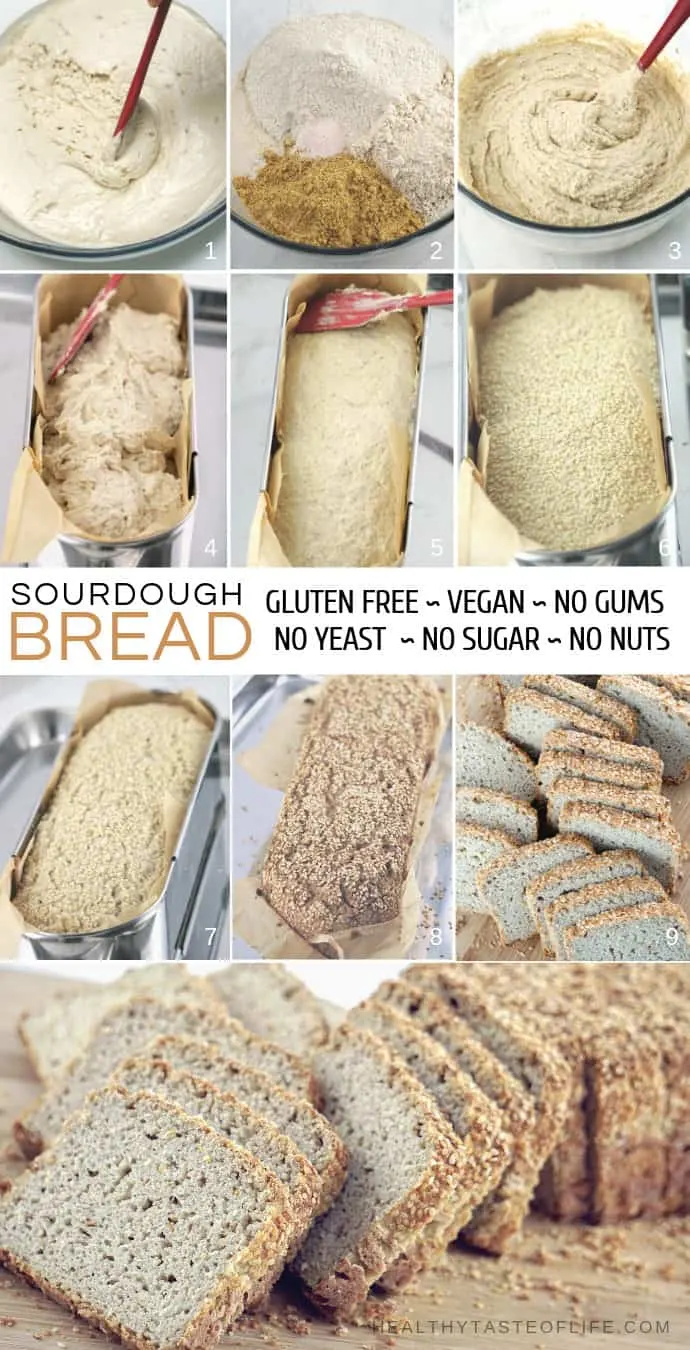
Gluten Free Sourdough Baking Tips & Tricks
- A larger percentage of sourdough starter in the dough allows it to rise in a cooler location and rise faster.
- If you want a less sour bread – reduce the fermentation time or increase the frequency of your feedings, this will create a more mild taste, minimize the alcohol content and reduce the overall acidity of the sourdough.
- Whole grain flours tend to contain more organisms to feed the yeasts and bacteria. Switching from a whole grain flour to white flour may cause a decline in the health of the starter.
- Always revive a dehydrated sourdough starter first with the flour type indicated on the package. Switch flours only when your sourdough starter has been fed for at least a week and is healthy, bubbling and growing.
FAQs In Gluten Free Bread Baking
It need more hydration, hence more water.
Because the dough is either too dry or the wrong ingredients in wrong proportions were added. Usually the addition of egg in gluten bread makes it crumbly.
Oat flour usually performs not very well when used to grow a gluten free sourdough starter.
You need the right proportions of denser flours and lighter gluten free flours, a good biding agent (like eggs, flax seeds or psyllium) and a good rising agent (yeast or sourdough starter).
Yes. For this, choosing lighter and starchier flour is one factor and the second, is using a good binding agent like eggs, flax seeds or psyllium husk.
Yes. You can replace the commercial dry yeast with a sourdough starter. It still contains natural wild type of yeast, that usually people with sensitives can tolerate.
More Healthy Gluten Free Bread Recipes
- Soft Buckwheat Bread Recipe (GF, DF)
- Gluten Free English Muffins (Vegan, Sourdough)
- Teff & Buckwheat Sourdough Bread | Gluten Free Pumpernickel
- Gluten Free Sourdough Buns (No Egg, Vegan)
Other Recipes Made With Gluten Free Sourdough Starter
- Soft Gluten Free Wraps / Tortillas (Vegan)
- Gluten Free Sourdough Pancakes – Light & Fluffy
- Gluten Free Sourdough Crackers With Seeds (Vegan)
How To Store This Vegan Gluten Free Sourdough Bread
The slices can be stored in a closed container or plastic bag at room temperature for up to 3-4 days. Freeze for longer storage. When needed, slices can go from freezer to toaster directly. Personally I like double toasting or toasting at the highest intensity of my toaster, the texture and smell is just incredible!
There is also another gluten free sourdough bread recipe version presented the recipe card, make sure to check them both out!
Vegan Gluten Free Sourdough Bread Recipe, Yeast Free, Gum Free
Ingredients
Activate The Gluten Free Sourdough Starter:
- 1 cup gluten free sourdough starter - active, see recipe here
- 1/2 cup brown rice flour - organic
- 1/2 cup filtered water, room temperature - or a bit less if your starter is more liquid.
Then Add To Form The Loaf:
- 1 cup buckwheat flour - light color
- 1 cup millet flour - oat flour or sorghum flour also works
- 1/3 cup flax seeds - ground
- 1½ cup filtered water - or plant milk
- 1 tsp Himalayan pink salt - or sea salt
- 1 tbsp maple syrup - optional
Another Recipe Version (yields better texture)
- 1 cup gluten free sourdough starter - active
- 2 cups water
- 1 tbsp psyllium husk - yields a more flexible texture
- 2/3 cup ground flax seeds - I increased the amount comparing to original recipe.
- 1 cup buckwheat flour - light color
- 1 cup gluten free oat flour
- 1 tbsp Himalayan pink salt - or 1½ tsp sea salt
- 1-2 tbsp maple syrup - optional
Instructions
- If you just bought your dehydrated gluten free sourdough starter, then follow the instructions on how to activate it in the booklet that comes with. Or see similar instructions in this post.
- Once the starter is active (is bubbling regularly within a few hours of feeding) take the amount of starter you need (1 cup). The rest of the jar place in the fridge covered with a cheese cloth and a rubber band. Now you can proceed to step 2, and add the rest of ingredients.
Step 1: Activate the gluten free starter that’s already stored in the fridge:
- Take the amount of starter you need, the rest feed it and place it back in the fridge.
- To that add 1/2 cup of brown rice flour, and 1/2 cup of filtered water. This step will activate the cold dormant starter. If your starter is thin and watery, use less water (about 1/3 cup). Let it sit in a warm (not hot) place for 3-4 hours until is light and bubbly. During winter it might take even 5 hours.
- If the starter is not too active (you don’t see too many bubbles) feed it again (brown rice flour + water). But you will need to use only 1 cup of starter for the recipe, the rest you can place in the fridge or use for another recipe.
Step 2: Form The Gluten Free Sourdough Loaf
- To the active starter add the rest of ingredients: the flours (sifted), water, salt and maple syrup (it's optional, but I use to enhance the taste plus the sugar makes the bread rise faster).
- Mix to combine. The dough should look like a thick batter or like a brownie batter. No kneading is required.
- If you're using 2nd recipe version, where I added more ground flax seeds and psyllium husk (this provides extra pliability) you'll need a little bit more moisture so I increased the amount to 2 cups (you may need a little bit more or less) see the final dough if it looks right. First you combine the starter with water and psillium husk, mix to combine, so it can expand a little bit. And then you add the rest of ingredients.
- Prepare the baking pan by lining it with parchment paper, it will prevent sticking. I'm using an extendable baking tin. It has no bottom so it's easy to remove while baking. Or use a high wall non-stick loaf tin.
- Scrape the dough into the pan and smooth it out with a spatula to produce a nice dome shape. Add seeds or nuts on top if you want.
- Cover with a plastic wrap or a towel to seal moisture (you can also spray the inside of the wrap with water to prevent dough cracking) and let it rise in a warm place approximately 4-5 hours. It depends on how warm is your kitchen.
Step 3: Bake The Vegan Gluten Free Sourdough Bread
- Preheat oven at 425 degrees F (220 C).
- Once ready to bake the bread, remove the wrap, cover with an aluminum foil (without touching it), turn the temperature down to 390 F (200 C) and bake for 30 minutes.
- Then remove the foil (at this time you can also remove the baking tin for an uniform baking on all sides) and bake for another 40-45 minutes until golden brown.
- Allow to cool completely before handling or slicing (use a serrated knife)! Best to do that the next day.
Video
Notes
Tips For Making The Best Vegan Gluten Free Sourdough Bread
- The ground flax seeds act as a binder and help the gluten free sourdough bread form a better structure. They are stable during baking and do not loose their health benefits like the flax seed oil does at high temperatures.
- Do not shake or touch the dough once it has risen and is ready to bake, it will collapse and loose it’s shape.
- Topping bread dough with seeds and grains is a great way to develop even more crunch and depth of flavor. You can experiment with mixing seeds, nuts and dried fruit.
- For a lighter in color bread use lighter gluten free flours, read more about choosing the right flours in the post above.
- If you can’t find gluten free (and organic) oat flour, use your blender to grind some rolled oats.
- If you want your gluten free sourdough bread to be more sour you can keep it 1 hour longer to ferment, otherwise you won’t feel the sourness much.
- Whole grain flours tend to contain more organisms to feed the yeasts and bacteria. Switching from a whole grain flour to white flour may cause a decline in the health of the starter.
- Always revive a dehydrated sourdough starter first with the flour type indicated on the package. Switch flours only when your sourdough starter has been fed for at least a week and is healthy, bubbling and growing.
- If you bought the dehydrated starter, read instructions on how to activate it here.
Nutrition
The information shown is an estimate provided by an online nutrition calculator.
©HealthyTasteOfLife. Content and photographs are copyright protected and need prior permission to use. Copying and/or pasting full recipes to other websites and any social media is strictly prohibited. Sharing and using the link of this recipe is both encouraged and appreciated!



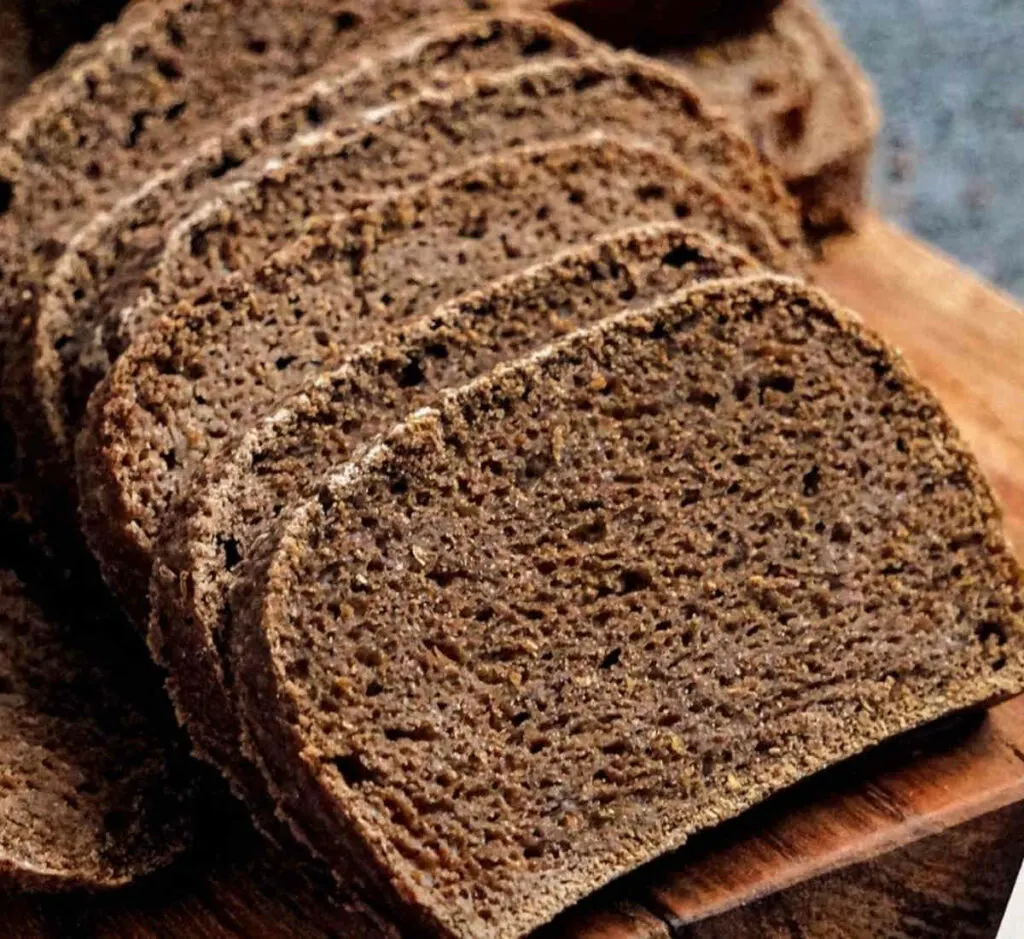
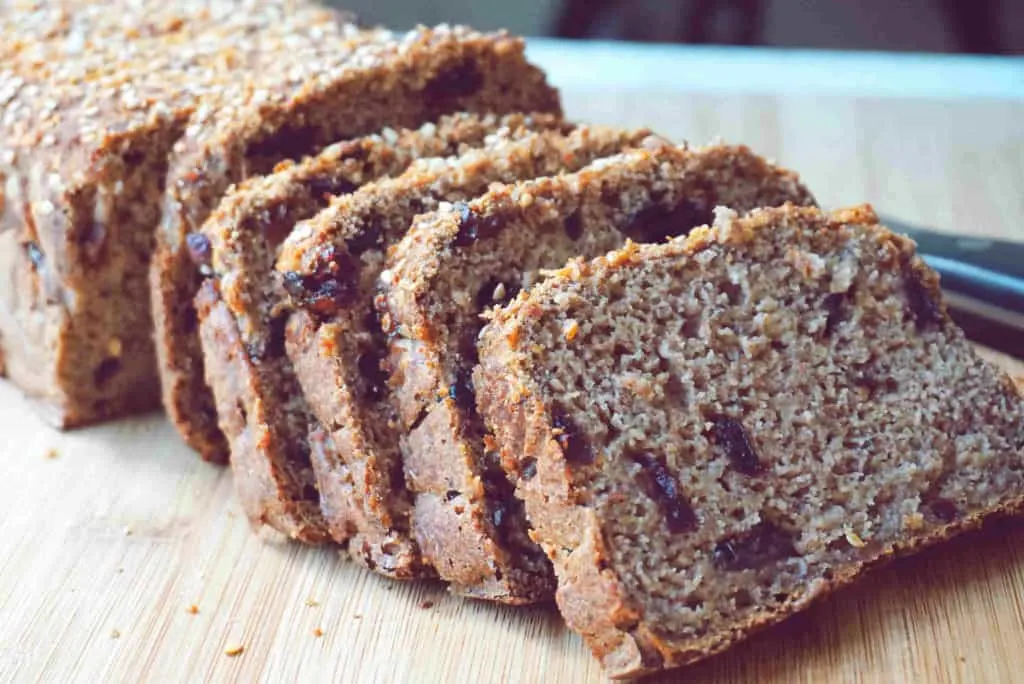
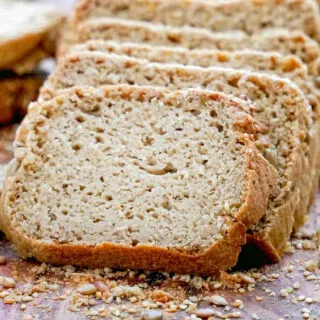
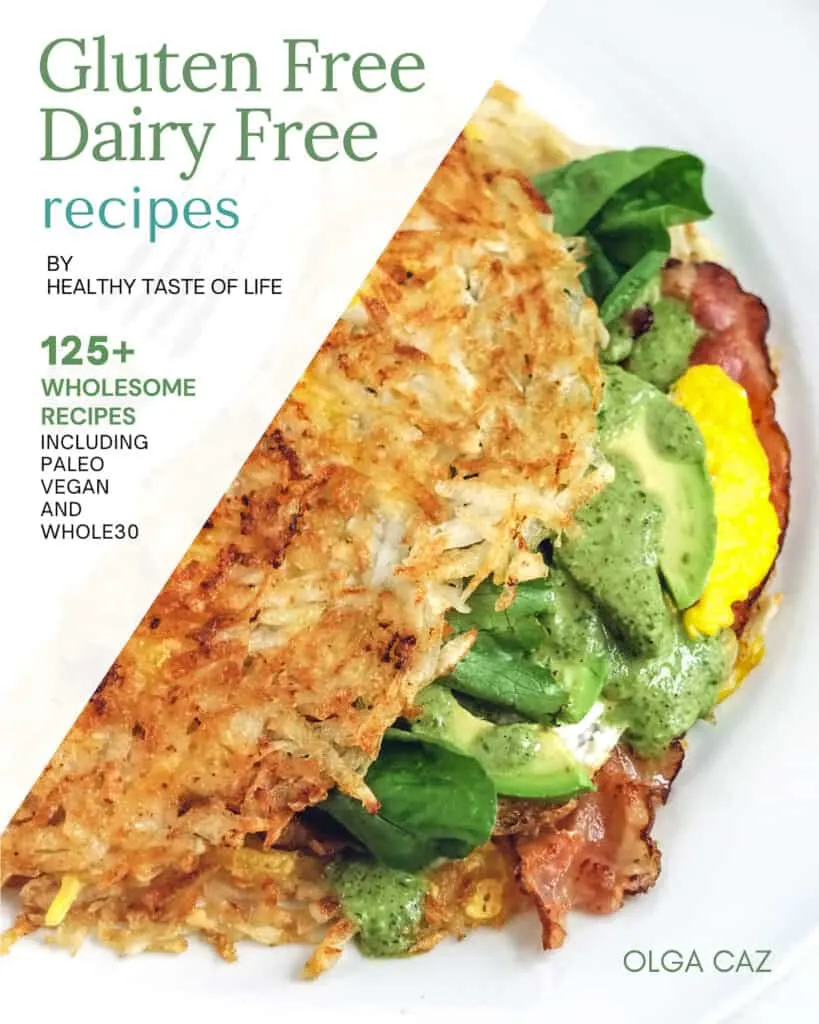
Sue
Sunday 24th of March 2024
Can you use sprouted gluten free flours in the sourdough starter?
HealthyTasteOfLife
Saturday 11th of May 2024
sure
Abigail
Thursday 13th of April 2023
So if I can't have flax or psylium but I CAN have egg, what is the no. of eggs to use? I know that flax is an egg replacer but I have no idea what the reverse conversion is from flax to eggs. LOL. I'd love to try this recipe otherwise . . . Can you help me please? Thanks!
Abigail
Friday 14th of April 2023
@HealthyTasteOfLife, Thank you!! Will give this a try!
HealthyTasteOfLife
Friday 14th of April 2023
I would remove the flax and psyllium and add 2 or 3 eggs, whatever you comfortable with. And also you will need to adjust (reduce) the amount of water, as the eggs provide extra moisture. You can add the water at the end , adding little by little and mixing. Once you get a similar consistency as shown in the images, you're goot to bake.
LJ
Monday 3rd of April 2023
Thanks for creating this amazing recipe! I am gluten free and this recipe was easy swaps with no weird or hard to find ingredients. It worked very well! I am not used to sourdough bread so it is an adjustment, but I look forward to experimenting with different toppings. This bread was very tasty!
HealthyTasteOfLife
Friday 14th of April 2023
I'm glad you tried and liked it, it's a pleasure to hear that! I hope you experiment more and find what you like.
Michelle
Thursday 22nd of September 2022
This was my first attempt at sourdough and I was very happy with the result! I only changed one thing - I did half of the buckwheat and subbed half brown rice flour. Will definitely be making again! Thank you for perfecting this recipe!
HealthyTasteOfLife
Wednesday 5th of October 2022
My pleasure! Thank you for your feedback Michelle!
Nicole Sparg
Saturday 17th of September 2022
Hi Olga, thank you for this lovely recipe! May I ask, if a person does not have a gluten free sourdough flour starter could I use ordinary yeast? I know that it is not the best option and will most certainly not give the same taste, but could that work? And if so how many grams could I use per loaf? Thank you!
HealthyTasteOfLife
Monday 19th of September 2022
I wish I could answer that. The process of gluten free baking with yeast is totally different from sourdough, so far I never tried it.